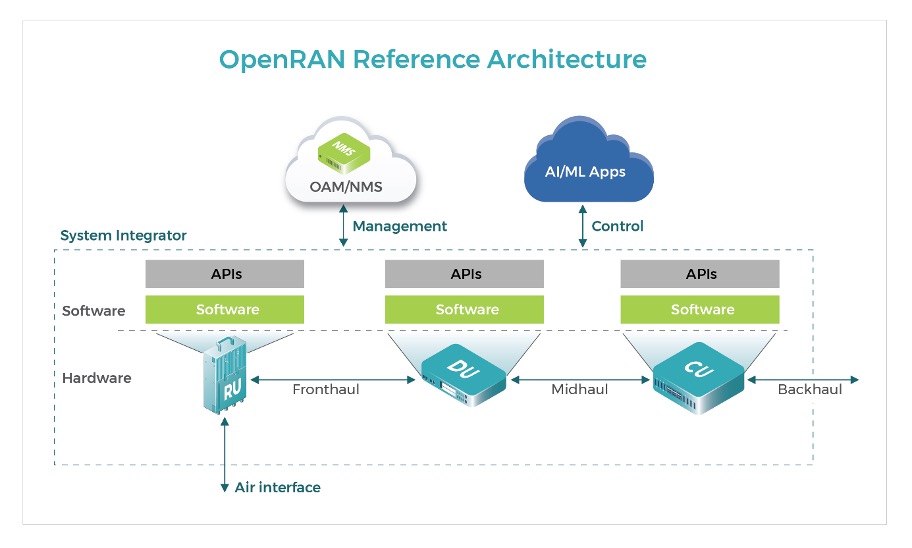Introduction
5G is still in development, and in addition to the 5G network itself, other technologies are also being developed that can be used for 5G. Since its inception in 2019, the 5G network has brought a revolution in terms of efficiency and reliability, both for ordinary users and large enterprises. 5G will bring significant impact in several directions, including broadband connectivity, sustainability, and machine-to-machine communication - M2M. [V13] Among the biggest trends expected in the next few years are Standalone 5G, use of artificial intelligence, Internet of Things, Next Generation Internet, and from a technological point of view OpenRAN technology.[V14]
OpenRAN is an architecture for cellular networks that allows a much more open and flexible approach to building an access radio network. The main feature is the separation of the hardware and software components of the radio network, which allows the selection of different combinations of individual components from suppliers, rather than the network being limited to a single supplier. In addition, it offers an open interface between individual components, further supporting the idea of component neutrality towards suppliers, different architecture options, the possibility to implement the solution either on physical hardware or virtually, and innovation by adapting new technologies. The reference architecture can be seen in Figure 3.[V15]

Fig, V3: OpenRAN Reference Architecture [V15]
The OpenRAN specification is handled by the O-RAN Alliance, which was established in 2018 and today consists of more than 30 operators and more than 200 supplier companies. As a basis for OpenRAN, standards from 3GPP are used, on which only RAN technology is extended. At the same time, it strives to implement mechanisms that will enable the use of artificial intelligence and machine learning, which makes it possible to achieve more efficient network management and orchestration.[V16] In addition, OpenRAN strives to be able to operate a radio access network through the cloud, further supports the idea of greater flexibility compared to the traditional access network. Since OpenRAN is software-controlled and intended for specific services in the network, it favors real-time services that require low response for non-critical services.[V17] At the same time, OpenRAN removes the limits for IoT connectivity by providing a flexible architecture that is suitable for modern IoT connectivity. This should allow more devices to be connected than in the case of a traditional RAN, and at the same time it will allow an existing network to be easily extended, reducing the cost of building the network.[V17]
Next Generation Internet is an initiative of the European Commission, which aims to direct the development and evolution of the Internet into the "Internet of People". It is an Internet that responds to people's basic needs, including trust, security, and inclusion, while at the same time reflecting the values and standards of all European citizens. The European Commission's initial investment in NGI research amounts to more than 250 million euros, and has already supported around 1,000 Internet researchers and innovators in hundreds of projects.[V18] The goal of the NGI initiative is to build the key technological building blocks of a human-centered Internet, giving end users full control over their personal data. Through advanced technologies, new decentralized businesses, and social models, it wants to ensure safe and trustworthy access for everyone. NGI's goal is to reimagine and evolve the Internet. The information age should enable human potential, mobility, and creativity in an inclusive manner, while responsibly treating natural resources. It tries to build an interoperable platform ecosystem from the Internet, which embodies the values of Europe, such as openness, inclusiveness, transparency, privacy, cooperation, and data protection. It wants to achieve that the user can freely choose from a range of decentralized digital solutions with freely available source code.[V19] NGI has also supported projects such as 5G Open RAN evolution based on OpenAirInterface, which aims to integrate OpenRAN interfaces implemented by Allbesmart. The goal is to promote innovation, especially for near-real-time RIC algorithms such as multi-user scheduling and resource allocation. The output of this experiment will contribute to the OpenAirInterface library with freely available source code.[V18] Another project she supported is an operating system with freely available source code intended for smartphones. The main goal of the project is to protect the user's data, while following the idea "Your data is YOUR data". It is a modified Android operating system, from which elements implemented by Google were removed. In addition, secure elements such as search, email client, and cloud storage have been added to the operating system. [V18] Another project that NGI has supported is LumoSQL. The project focuses on the SQL database, specifically on SQLite, which he says is not as reliable as it could be, and at the same time it lacks features such as encryption and safe use in a network environment. The goal of the project is to create a suitable alternative that could be easily replaced by the SQLite database, thereby making applications more secure.[V18]